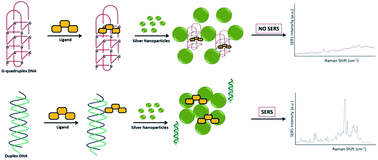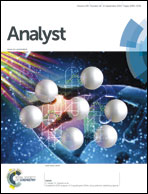Qualitative SERS analysis of G-quadruplex DNAs using selective stabilising ligands
Abstract
Nucleic acids are of key biological importance due to their range of functions and ability to form various different structures, with an example of emerging significance being quadruplexes formed by guanine-rich sequences. These guanine rich sequences are found in different regions of the genome such as telomeres, gene promoters and introns and UTRs of mRNAs. Here a new approach has been developed that utilises surface enhanced Raman scattering (SERS) for the detection of the formation of G-quadruplexes. Three G-quadruplex stabilising ligands that each have their own unique SERS response were used in this study and their ability to act as reporters assessed. A SERS response was only obtained from the ligands in the absence of G-quadruplex formation. This resulted in an “on/off” method which was successfully used to qualitatively detect the formation of G-quadruplex using quadruplex-forming sequences such as human telomeric and C-MYC promoter DNAs. The unique SERS spectra of each stabilising ligand offer the potential for use of SERS to study higher order DNA structures. This work shows that the ligands used can act simultaneously as a potential therapeutic stabilising agent and a SERS reporter, therefore allowing the use of SERS as a method of analysis of the formation of G-quadruplex DNAs.


 Please wait while we load your content...
Please wait while we load your content...